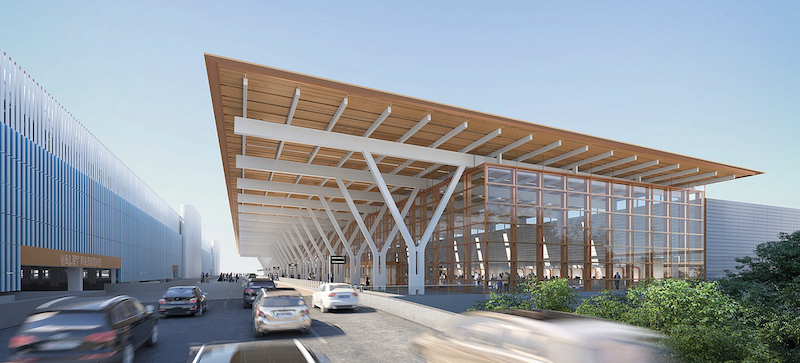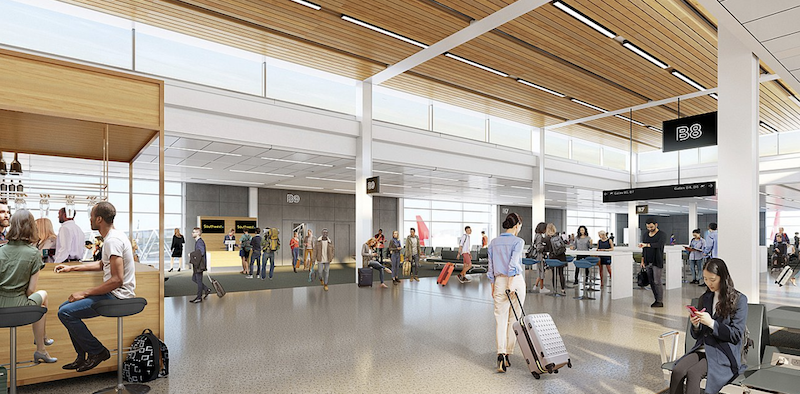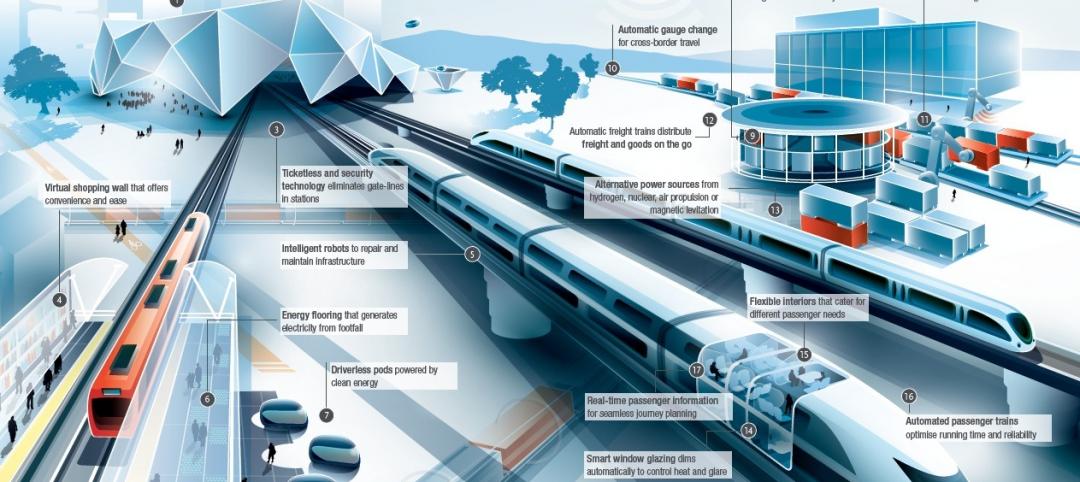Kansas City International Airport’s new 1 million-sf terminal has broken ground. The project, which is designed by SOM, will set a new standard for inclusivity and accessibility.
The 39-gate terminal will have the flexibility to expand to 50 gates in the future. At the entrance, a large overhang, supported by structurally expressed Y columns, and a glass facade will create a grand and transparent space while retail spaces and two concourses will step down toward a human scale. The rhythmic expressed steel structural system is balanced by a natural wood inlay to provide inviting spaces for passengers. Outdoor waiting areas will leverage the site’s surrounding natural landscape to provide a calming space.

The design forgoes creating a sprawling terminal and instead focuses on quick and seamless transitioning with a compact layout: walking distances are kept to a minimum, check-in and security are consolidated into one space, and a dual-level roadway will separate the vehicular traffic between arrivals and departures, with the terminal’s entrance and passenger-parking facilities located on either side to make the entire airport walkable.
The terminal will feature a variety of spaces with the goal of increasing inclusivity and accessibility. A multi-sensory room will provide a quiet and secure place for people with autism, dementia, or sensory processing disorders. An airplane simulation room will help people with anxiety or other conditions that create a fear of flying. This room allows people in experience and fear about air travel through true-to-life objects like a ticketing kiosk, gate door, passenger boarding bridge, and simulated aircraft cabin.

Other inclusivity and accessibility features include a meditation room, a family play zone, all gender restrooms, family restrooms, infant nursing rooms, service animal relief areas, and adult-assist changing rooms.
In addition to SOM, the build team also includes Edgemoor Infrastructure & Real Estate (developer), and Clark | Weitz | Clarkson (design-builder).
The new terminal is targeting LEED Gold certification. The project is slated for completion in 2023.


Related Stories
| Jul 18, 2014
Engineering firms look to bolster growth through new services, technology [2014 Giants 300 Report]
Following solid revenue growth in 2013, the majority of U.S.-based engineering and engineering/architecture firms expect more of the same this year, according to BD+C’s 2014 Giants 300 report.
| Jul 18, 2014
Top Engineering/Architecture Firms [2014 Giants 300 Report]
Jacobs, AECOM, Parsons Brinckerhoff top Building Design+Construction's 2014 ranking of the largest engineering/architecture firms in the United States.
| Jul 18, 2014
Top Engineering Firms [2014 Giants 300 Report]
Fluor, Arup, Day & Zimmermann top Building Design+Construction's 2014 ranking of the largest engineering firms in the United States.
| Jul 18, 2014
Top Architecture Firms [2014 Giants 300 Report]
Gensler, Perkins+Will, NBBJ top Building Design+Construction's 2014 ranking of the largest architecture firms in the United States.
| Jul 18, 2014
2014 Giants 300 Report
Building Design+Construction magazine's annual ranking the nation's largest architecture, engineering, and construction firms in the U.S.
| Jul 7, 2014
7 emerging design trends in brick buildings
From wild architectural shapes to unique color blends and pattern arrangements, these projects demonstrate the design possibilities of brick.
| Jul 2, 2014
Emerging trends in commercial flooring
Rectangular tiles, digital graphic applications, the resurgence of terrazzo, and product transparency headline today’s commercial flooring trends.
| Jun 30, 2014
Arup's vision of the future of rail: driverless trains, maintenance drones, and automatic freight delivery
In its Future of Rail 2050 report, Arup reveals a vision of the future of rail travel in light of trends such as urban population growth, climate change, and emerging technologies.
| Jun 18, 2014
Arup uses 3D printing to fabricate one-of-a-kind structural steel components
The firm's research shows that 3D printing has the potential to reduce costs, cut waste, and slash the carbon footprint of the construction sector.
| Jun 12, 2014
Austrian university develops 'inflatable' concrete dome method
Constructing a concrete dome is a costly process, but this may change soon. A team from the Vienna University of Technology has developed a method that allows concrete domes to form with the use of air and steel cables instead of expensive, timber supporting structures.

















